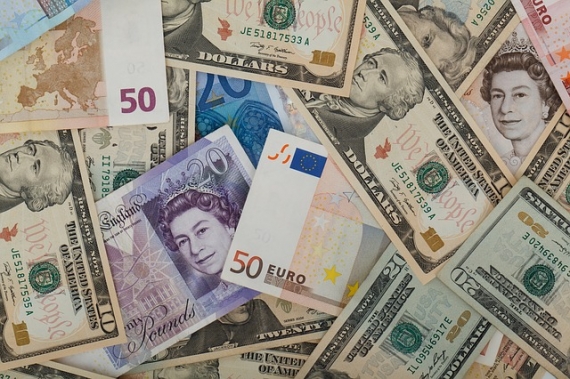
When looking at the impact of economic calendar events, the key aspect is to understand why currency rates move in the first place. The interaction of economic events on underlying trends and changing expectations will be the dominant factor in determining currency levels.
The biggest impact of economic calendar 2018 data will come when there is a shift in sentiment and expectations at important turning points.
Supply and demand remain crucial
At its most basic level, currency rates are determined by supply and demand, as is the case for other commodities. If there is an increase in supply of a currency with no increase in demand a currency will tend to lose value or depreciate.
In contrast, stronger demand for a currency with no change in supply would tend to strengthen a currency.
Economic data on the calendar is used primarily to assess potential trends in interest rates which have a key influence on demand for currencies.
Interest rate changes
Changes in interest rates are the most important economic calendar event for currencies given the impact on yields! These meetings are scheduled many months in advance and are key set-piece events on the economic calendar.
Higher rates will tend to put upward pressure on currencies due to improved yields while lower rates tend to undermine currencies, although this is by no means guaranteed.
If a central bank appears to have tightened monetary policy too far and the action is risking recession, there will tend to be a negative reaction. Any cut in rates which is seen to support growth could also generate a positive reaction.
Central bank speeches
As well as the regular policy meetings, key central bank officials will also make several speeches during the year. The most important of these are by the bank Governors and comments from other officials who have responsibility for setting interest rates can also have a notable impact.
Officials will use these speeches to provide guidance on their expectations and can be extremely important in signalling future potential interest rate moves by the central bank.
Employment data
Employment data has an important impact on currency values as it is a key indicator of confidence in an economy. It is known as the #1 economic calendar event in the USA. The most important global release is the monthly data on US non-farm payrolls released on the first Friday of the month.
A strong reading for employment increases confidence in the underlying economic outlook. If markets are confidence in the outlook, there will be increased currency demand and there will be expectations that the central bank will raise interest rates. Strength in the labour market also increases the potential for higher interest rates which tends to boost currency values.
GDP growth
GDP growth is the most visible indicator of underlying economic performance and market reactions are relatively straight forward.
A strong reading for GDP boosts underlying confidence in the outlook and reinforces expectations that the outlook is favourable. If growth appears to be strengthening too fast, there will also be pressure for higher interest rates.
In contrast, weak growth undermines confidence, increases fears over the threat of recession and increases speculation over lower interest rates.
As well as the GDP data, there are several other indicators which play an important role in assessing underlying growth prospects.
Retail sales
Retail sales data is important in assessing trends in consumer spending. Given the dominance of services and consumer spending in modern economies, trends in consumer spending also play a key role in overall GDP growth.
Again, the overall reaction to retail sales data is relatively straight-forward. Strong data will put upward pressure on a currency while weak data will have a negative impact.
Industrial production
Industrial production provides evidence on the state of industry. Although consumer spending data is more important for overall growth within the economy, trends in output growth are an important underlying indicator of underlying economic health.
Trends in industrial production also provide an important signal surrounding competitiveness. If production growth is weak with poor export growth, there will be increased concerns that currency strength is undermining the competitive position.
PMI data
The Purchasing Managers Index (PMI) is an increasingly important economic indicator. The data is compiled from surveys sent to purchasing managers. This is particularly important as it is based on what purchasing managers are actually doing. As well as the headline data which is used as a proxy for GDP growth, there is also data on orders, employment and prices.
A rising PMI index indicates a strengthening economy while a weaker tone signals underlying deterioration.
Inflation and consumer prices
Inflation is a very important indicator, although great care is needed in interpreting the data.
On a short-term view, higher inflation and a move above a central bank target rate tends to support a currency, primarily due to expectations that the central bank will need to tighten monetary policy in order to bring inflation back on track towards the target.
Lower inflation, therefore, tends to weaken a currency on expectations that interest rates could be cut.
On a longer-term however, high inflation has a key role in undermining a currency. A currency is fundamentally a store of value and higher inflation erodes this value in real terms.
If a country persistent runs a high inflation rate in comparison to other major economies, the currency will weaken.
Trade and current account data
Trade data has only a limited impact for much of the time, although there is no room for complacency as concerns can suddenly escalate and trigger substantial currency moves.
The level of a trade account is important, although rapid changes in the balance tend to have a larger impact. If a country is running a persistent trade surplus, there will tend to be structural upward pressure on a currency while a persistent deficit would tend to put downward pressure on a currency. If the trade account deteriorates sharply, there will be fears over a weakening economic performance and loss of competitiveness, both factors which will undermine a currency.
A sharp improvement in the trade account would increase confidence in the outlook and suggest that a currency is undervalued.
The current account data includes transactions in services as well as net income received by a country. A deficit above 5% of GDP is a very important warning that a currency is liable to come under pressure.
Currency reserves
The level of currency reserves has only limited impact on most major economies given that currencies float, but they are a very important indicator when a central bank is attempting to keep a fixed currency rate or stop a currency falling.
If reserves decline sharply when a currency is being defended, this is a clear warning that the situation is unlikely to be sustainable.
Concluding words
If you are carefully following currency fluctuations and constantly checking the exchange rates then you should be sure that you are in sync with the Economic Calendar of 2018.

















